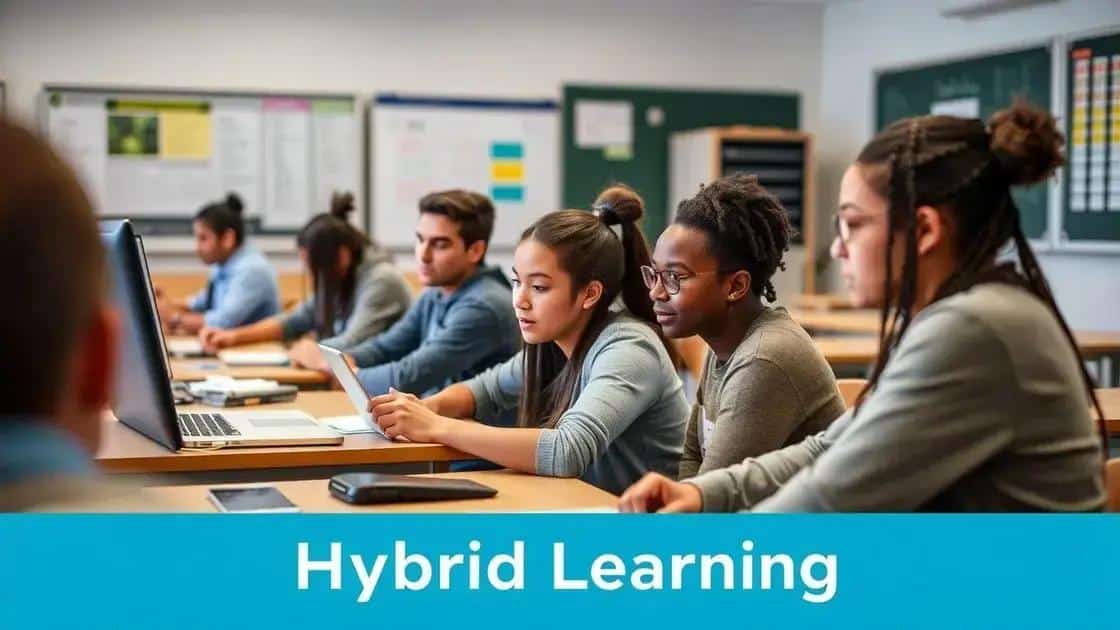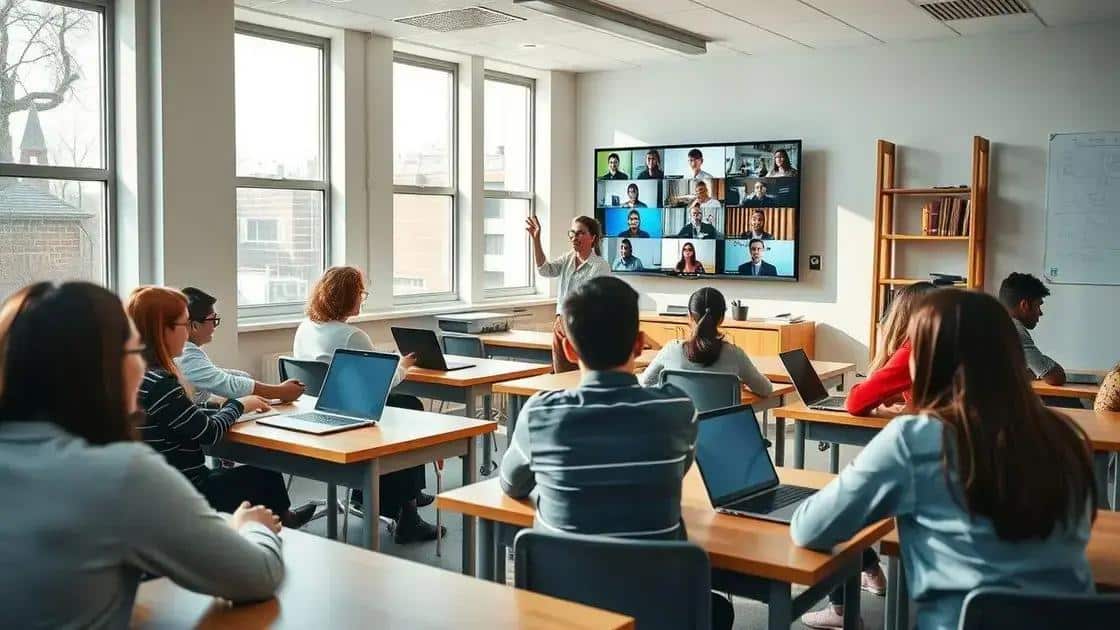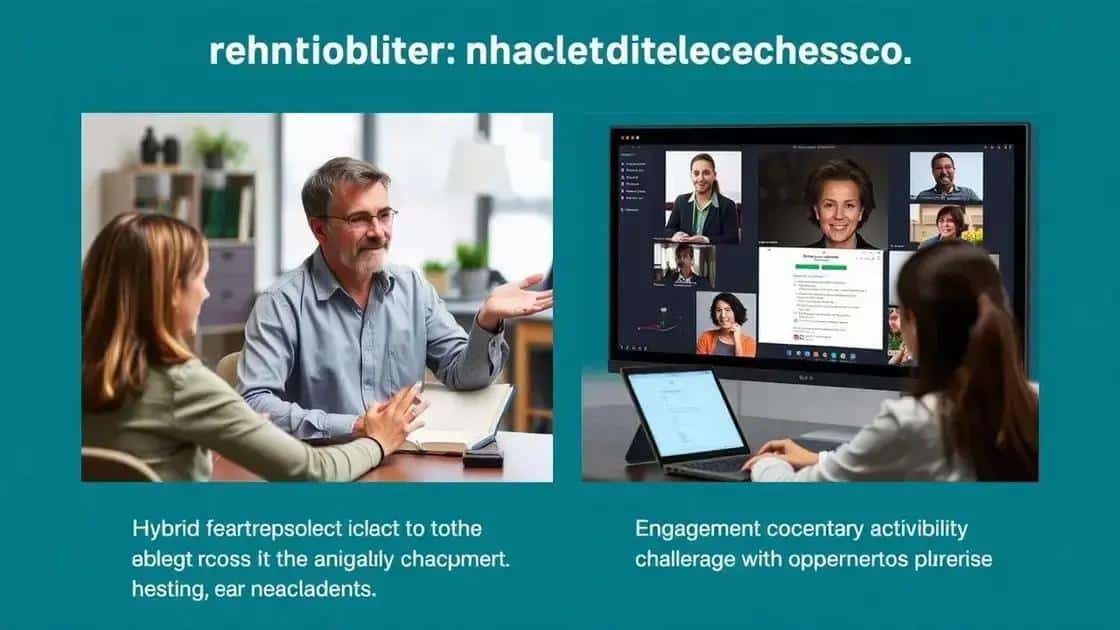Insights on hybrid learning success: unlock the potential

Hybrid learning combines in-person and online education, offering flexibility and personalization while addressing challenges like engagement and technology access through effective tools and strategies.
Insights on hybrid learning success are shaping the future of education. Imagine a learning environment where face-to-face and online instruction meet seamlessly. How can this blend enhance your learning experience?
Understanding hybrid learning
Understanding hybrid learning is essential for educators and students alike. This approach combines traditional face-to-face instruction with online learning. By integrating these two methods, we can enhance the learning experience and provide more flexibility.
What is hybrid learning?
Hybrid learning is a mix of in-person and virtual learning formats. Students can attend classes on-site while also having the option to learn online. This system supports different learning styles and paces.
Benefits of hybrid learning
- Flexibility: Students can choose how they want to learn, fitting education into their lives more easily.
- Personalization: Tailored content can meet individual learning needs, helping students engage better.
- Resource availability: Online resources can enhance the classroom experience and provide additional materials.
- Collaboration: Technology allows for seamless collaboration between students and instructors, even when they are not in the same room.
By using technology effectively, educators can create a more engaging and immersive environment. For instance, live chats and discussion boards foster lively discussions and community building among students. The combination of in-person support with the vast resources available online leads to a richer educational experience.
Moreover, teachers can utilize various platforms to monitor student progress closely. This way, they can provide immediate feedback and adapt their teaching strategies to meet every student’s needs. It’s a win-win for both students and educators.
As we explore hybrid learning, it’s vital to recognize the value it brings to education. Successfully implementing a hybrid model requires clear communication, consistent technology use, and support for both teachers and students.
Key factors for successful hybrid learning

Key factors for successful hybrid learning include effective communication, technology integration, and consistent engagement. These aspects play a crucial role in creating a thriving educational environment.
Effective communication
Clear communication between instructors and students is vital in a hybrid setting. Educators must be accessible and provide timely feedback. Setting expectations helps students understand their responsibilities and boosts their accountability.
Technology integration
Utilizing the right technology tools makes a big difference in hybrid learning. Platforms for video conferencing, assignment submissions, and resource sharing streamline the process. Educators should consider:
- Learning management systems: These consolidate course materials and communication.
- Interactive tools: Utilizing apps that foster engagement keeps students interested.
- Accessibility options: Ensuring that all students can access materials is critical.
Moreover, training for both students and teachers on how to use these tools is essential. This helps everyone become comfortable and confident in the hybrid model. In addition to technology, creating an engaging environment keeps motivation high.
Consistent engagement
To maintain student interest, educators should implement regular check-ins and discussions. This fosters a sense of community among peers, even in a virtual setting. Utilizing breakout rooms during online sessions can encourage smaller group interactions, making discussions more dynamic.
Incorporating project-based learning can strengthen understanding and teamwork. Students can collaborate on assignments, bridging the gap between in-person and online interactions. With these key factors, hybrid learning can truly succeed and provide a balanced educational experience.
Effective tools for hybrid education
Effective tools for hybrid education play a key role in enhancing the learning experience. With the right technologies, educators can create an interactive and engaging environment for students, whether they are in-person or online.
Learning Management Systems (LMS)
LMS platforms are essential for organizing course materials and facilitating communication. These systems allow educators to share assignments, track progress, and provide feedback efficiently. Some popular LMS options include:
- Canvas: Offers a user-friendly interface and various integrations.
- Google Classroom: Provides simple functionality for managing classes and assignments.
- Moodle: An open-source platform ideal for customizable learning experiences.
These systems centralize resources, making it easier for students to access materials anytime, anywhere.
Video Conferencing Tools
Video conferencing tools are crucial for real-time interaction in hybrid learning. They allow for live sessions where teachers can engage students directly. Tools like:
- Zoom: Popular for its breakout rooms and screen-sharing features.
- Microsoft Teams: Integrates seamlessly with other Microsoft products and offers collaborative features.
- Google Meet: Simple to use and connects easily with Google Workspace.
These platforms facilitate discussions, presentations, and group activities, making learning more dynamic.
To enhance student engagement, educators can also use interactive tools such as polls and quizzes during sessions. Tools like Kahoot! and Mentimeter allow for real-time feedback and participation, keeping students active and involved.
Additionally, utilizing resource sharing tools such as Dropbox or Google Drive helps in easily distributing materials and collaborating on group projects. By incorporating these effective tools, educators can bridge the gap between online and face-to-face learning, ensuring a cohesive educational experience.
Challenges and solutions in hybrid learning

Challenges and solutions in hybrid learning are crucial topics for educators and students. While this approach offers many benefits, it also presents unique difficulties that need to be addressed for success.
Common challenges
One major challenge is maintaining student engagement. When learning occurs both online and offline, some students may feel disconnected. They can struggle to stay focused or miss out on important interactions. Another challenge is ensuring that all students have access to the necessary technology. Students from different backgrounds may have varying levels of resources available to them.
Addressing engagement issues
To tackle engagement, teachers can implement regular interactive activities. For example, using polls, quizzes, and breakout groups during lessons can keep students actively participating. Additionally, fostering a sense of community is important. Establishing virtual study groups or discussion forums helps students connect, reducing feelings of isolation.
Improving technology access
Addressing technology access can be handled through several solutions. Schools can provide devices for students in need or set up loan programs. Partnering with local organizations to improve internet access for families is another effective approach. Schools should communicate openly with families about available resources so they can receive proper support.
Another approach to overcoming challenges is to provide teachers with ongoing training. This enables them to develop skills for managing a hybrid classroom effectively. Training sessions on technology use or engagement strategies can significantly enhance teaching methods.
Adopting a flexible mindset allows educators to experiment with various strategies. What works for one group may not be effective for another. By staying adaptable, teachers can find the best methods to meet their students’ needs.
FAQ – Frequently Asked Questions about Hybrid Learning
What are the main challenges in hybrid learning?
Common challenges include maintaining student engagement and ensuring all students have access to necessary technology.
How can I improve student engagement in hybrid classes?
Using interactive tools such as polls and breakout discussions can help keep students engaged during lessons.
What tools are effective for hybrid education?
Learning Management Systems (LMS) like Canvas and video conferencing tools like Zoom are essential for organizing classes and facilitating communication.
How can schools address technology access issues?
Schools can provide devices for students in need or create partnerships with local organizations to improve internet access.





